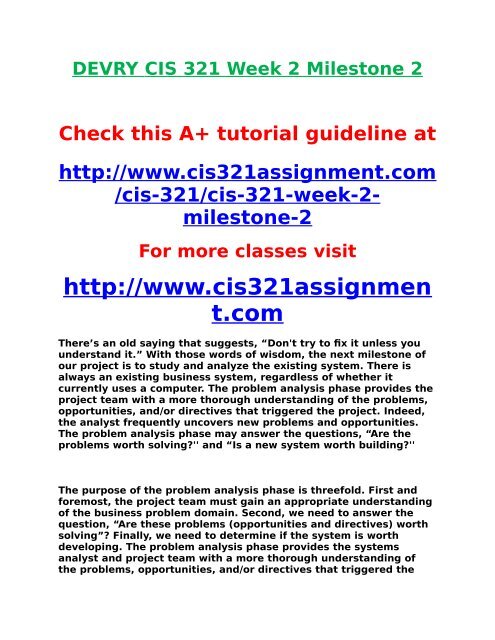DEVRY CIS 321 Week 2 Milestone 2
Create successful ePaper yourself
Turn your PDF publications into a flip-book with our unique Google optimized e-Paper software.
<strong>DEVRY</strong> <strong>CIS</strong> <strong>321</strong> <strong>Week</strong> 2 <strong>Milestone</strong> 2<br />
Check this A+ tutorial guideline at<br />
http://www.cis<strong>321</strong>assignment.com<br />
/cis-<strong>321</strong>/cis-<strong>321</strong>-week-2-<br />
milestone-2<br />
For more classes visit<br />
http://www.cis<strong>321</strong>assignmen<br />
t.com<br />
There’s an old saying that suggests, “Don't try to fix it unless you<br />
understand it.” With those words of wisdom, the next milestone of<br />
our project is to study and analyze the existing system. There is<br />
always an existing business system, regardless of whether it<br />
currently uses a computer. The problem analysis phase provides the<br />
project team with a more thorough understanding of the problems,<br />
opportunities, and/or directives that triggered the project. Indeed,<br />
the analyst frequently uncovers new problems and opportunities.<br />
The problem analysis phase may answer the questions, “Are the<br />
problems worth solving?'' and “Is a new system worth building?''<br />
The purpose of the problem analysis phase is threefold. First and<br />
foremost, the project team must gain an appropriate understanding<br />
of the business problem domain. Second, we need to answer the<br />
question, “Are these problems (opportunities and directives) worth<br />
solving”? Finally, we need to determine if the system is worth<br />
developing. The problem analysis phase provides the systems<br />
analyst and project team with a more thorough understanding of<br />
the problems, opportunities, and/or directives that triggered the
project. In the process, they frequently uncover new problems and<br />
opportunities.<br />
In this milestone you will perform Cause-Effect Analysis on the<br />
Employee Benefits System (EBS) and document your findings using<br />
the Problems, Opportunities, Objectives, and Constraints Matrix.<br />
The PIECES framework, originally developed by James Wetherbe and<br />
then adapted by the authors, can serve as a useful tool to classify<br />
the various problems, opportunities, and directives identified in<br />
<strong>Milestone</strong> 1.<br />
Objectives<br />
After completing this milestone, you should be able to:<br />
• Perform a Cause-Effect Analysis to be able to thoroughly<br />
understand a system’s problems, opportunities, and/or directives<br />
that triggered the project.<br />
• Use and understand the PIECES framework for classifying<br />
problems, opportunities, and directives.<br />
• Complete the Problems, Opportunities, Objectives, and<br />
Constraints Matrix.<br />
• Complete the List of Business Activities based on<br />
Requirement analysis.<br />
Prerequisites<br />
Before starting this milestone, the following topics should be<br />
covered:<br />
• The problem analysis phase — Chapters 3 and 5<br />
• PIECES framework — Chapters 3 and 5<br />
• Problem analysis techniques — Chapter 6<br />
• <strong>Milestone</strong> 1 Solution
Assignment<br />
Now that we have completed the preliminary investigation of the<br />
system and gained approval to proceed, we can attempt to gain a<br />
better understanding of the current system.<br />
In this assignment we will use our results of <strong>Milestone</strong> 1, plus the<br />
Case background information, in order to perform cause-effect<br />
analysis. The results of this activity will provide us a better<br />
understanding of the problems, opportunities, and constraints of<br />
the current system.<br />
Activities<br />
1. To complete the Problems, Opportunities, Objectives, and<br />
Constraints Matrix, using facts presented in the case introduction.<br />
Use the PIECES framework as a model to classify the problems,<br />
opportunities, and directives.<br />
2. To compile a List of business activities based on business<br />
requirements. It has to include the main tasks which have to be<br />
implemented.<br />
Deliverable format and software to be used are according to your<br />
instructor’s specifications. Deliverables should be neatly packaged<br />
in a binder, separated with a tab divider labeled “<strong>Milestone</strong> 2”.<br />
References and Templates<br />
• Problems, Opportunities, Objectives, and Constraints Matrix<br />
Template (link on <strong>Week</strong> 3 iLab page)<br />
• Case Introduction<br />
Deliverables:<br />
Problems, Opportunities, Objectives,
and Constraints Matrix:

















